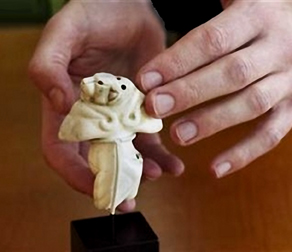 This is a very famous stone sculpture called the Guennol Lioness. It’s not only one of the smallest, but also one of the world’s most expensive figures, selling for $57.2 million and it stands a whopping 3 ¼ inches tall. Made of crystalline limestone, it is a tribute to the unknown master’s hand that created this diminutive tour de force. It’s also one of my favorite ancient figurines.
This is a very famous stone sculpture called the Guennol Lioness. It’s not only one of the smallest, but also one of the world’s most expensive figures, selling for $57.2 million and it stands a whopping 3 ¼ inches tall. Made of crystalline limestone, it is a tribute to the unknown master’s hand that created this diminutive tour de force. It’s also one of my favorite ancient figurines.
It was carved about 5,000 years ago in the Proto-Elamite, Chalcolithic era, giving lie to the belief that earlier cultures were not as advanced aesthetically or artistically as modern people. It was found in the middle 1930s in southwest Persia (now Iran) and sold to a private collector and displayed in the Guennol Collection, which was exhibited in various museums. The lionesses’ powerful lines come through despite the small size, giving us a feeling that this anthropometric creature was imbued with great power.
 The statue came to my attention several years back when it was put up for auction and new photos were made and released to the public. Previously, there were only grainy pictures in archeological texts, now we can enjoy the figure’s magnificent lines in crisp, new photos and wonder in the power of an ancient stone carver’s art. The holes at the top of the head may have been attachment points for a crown or some other embellishment and the holes at the base of the spine might have held the figure upright. The lower legs and feet are gone and we may never know exactly how it was displayed.
The statue came to my attention several years back when it was put up for auction and new photos were made and released to the public. Previously, there were only grainy pictures in archeological texts, now we can enjoy the figure’s magnificent lines in crisp, new photos and wonder in the power of an ancient stone carver’s art. The holes at the top of the head may have been attachment points for a crown or some other embellishment and the holes at the base of the spine might have held the figure upright. The lower legs and feet are gone and we may never know exactly how it was displayed.For Call of Cthulhu RPG players, this is just an example of rare treasures that were found in the 19th and early 20th century. Imagine a power play for possession of such an artifact that could be hidden nearly anywhere and in anything. It is easily concealable on a person and transported, making everyone not above suspicion. It could be hidden in a child’s doll, a box of candy or carried by an unsuspecting mule a treasure like this men would kill for, museums would bid for and people would spend their lives digging in the ends of the Earth just for the hope of possession. A scenario could easily be written about this real-life "Maltese Falcon" for RPGs. Truly, it is "the stuff dreams are made of."
CoastConFan


That is beautiful. We know so little about the past and much of the current "knowledge" is one find away from being invalidated.
ReplyDeleteUsing a real world item in a game makes it more engaging and helps the players cross the third wall and actualize themselves in the adventure.
ColKG